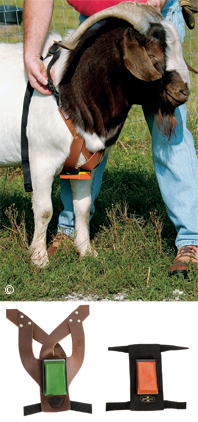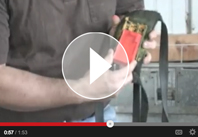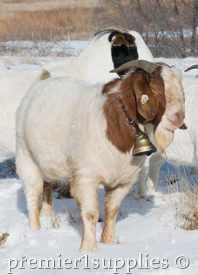HARNESSES & CRAYONS

Cross Your Heart Breeding Harness.
Most users need to re-adjust the harness weekly (active bucks lose weight during breeding). Change crayon colors to record which week does were marked.
Breeding Harnesses
Crayons
For use with either the Nylon or Cross Your Heart breeding harness. A metal cotter pin and 2 plastic pins supplied with each crayon. Plastic case protects crayons during transport.
Available in 3 temperature ranges. Temperature range (based on average daily high).
The mark’s scourability is disputed. The Kiwi manufacturer says it is. However, ASI’s tests indicate that this is not always true.
BREEDING HARNESS HOW-TO
"Mark" your
breeding season
Breeding harnesses and crayons are invaluable tools during the breeding season. They identify which does have been bred and whether or not the bucks are pulling their weight.
We run breeding groups through our handling equipment weekly during the breeding season to check the does that have been bred, record their ear tag number and the date. Five months down the road we sort by ear tag and date and get the nannies into our kidding jugs. We wouldn't be able to do this w/o the aid of a marking harness.
HOW-TO VIDEO

Click above to view our "how-to replace crayons on a ram marking harness".
GOAT ACCOUTREMENTS

Our Boer billy modeling a Ram Bell and collar. The bell's tone lets us know the location of our goat herd in the pasture. For ear tags, check out our Q-flex® line of scrapie approved tags.
It says Ram Bell but it works for bucks too!
It's a heavy-duty bell for use on rams or bucks. Can be laser imprinted with the buck's name or your name/address in case he decides to go for a walkabout.
Collars
Best used for holding buck (ram) bells. Made of a tough nylon that can handle the most ornery of goats. 26" long. Fits around the necks of most does. Measure the neck of the goat before ordering the collar. We are looking into sourcing a larger collar.
|
 |
 |

A few meat goats lined up and ready for feeding time. Getting goats to organize themselves in an orderly fashion is a feat not often seen.
Getting the goats
through the winter
It's cold, there's snow on the ground covering the grass but our goats still seem to be quite happy. They have plenty of scrub to browse in our thicket, plus a big bale of baleage that goes a long way to satisfying their appetites.
Below is an article on feeding silage to goats. It covers topics from which acids need to be present to signs of bad silage.
AN OPTION FOR GOAT FEEDING
Silage for Goats
By John Hibma
Dairy Goat Journal
Goats are natural browsers in the wild, being very selective of what they eat. If the seasonal nutritive values of browse and other feedstuffs decline or fluctuate, silage can be a good alternative, especially in production situations that require consistent nutrition on a daily basis.
Feeding silage to goats is generally safe but does come with some risks and challenges. There is nothing inherently wrong with feeding silage to goats. Like all ruminants, goats can digest fermented feeds quite well. However, as with all forages, quality and nutritional value, as well as price, should be the deciding factors when considering feeding silage to dairy goats. While silages are an excellent way to preserve forages, improperly processing, ensiling and possible mishandling after ensiling can result in a dangerous product that will have an ill effect on goats. As with any forage, maturity and preparation at the time of harvest is critical to its quality and nutritional value.
Silage is the product formed when a forage crop such as grass, alfalfa or corn is fermented so as to preserve it in a state of high moisture while at the same time preventing it from decay. In theory, any organic material containing sugar or starch can be ensiled provided there’s enough of it to justify the effort. Ensiling grass is a good alternative to baling when the weather doesn’t cooperate.
The key to making good silage is to use the weight of the crop to squeeze out all of the air, arresting the natural process of oxidation and decay after the crop has been harvested. There are essentially three ways of ensiling crops: in a vertical silo (the kind visible on many dairy farms throughout the country), in horizontal bunkers (usually constructed of cement floors and walls), and in the long, plastic, tubular bags that are generically referred to as “ag bags” by those in the know. Each method, when done correctly, will yield high quality silage for animal feed.
Read More »
|
|